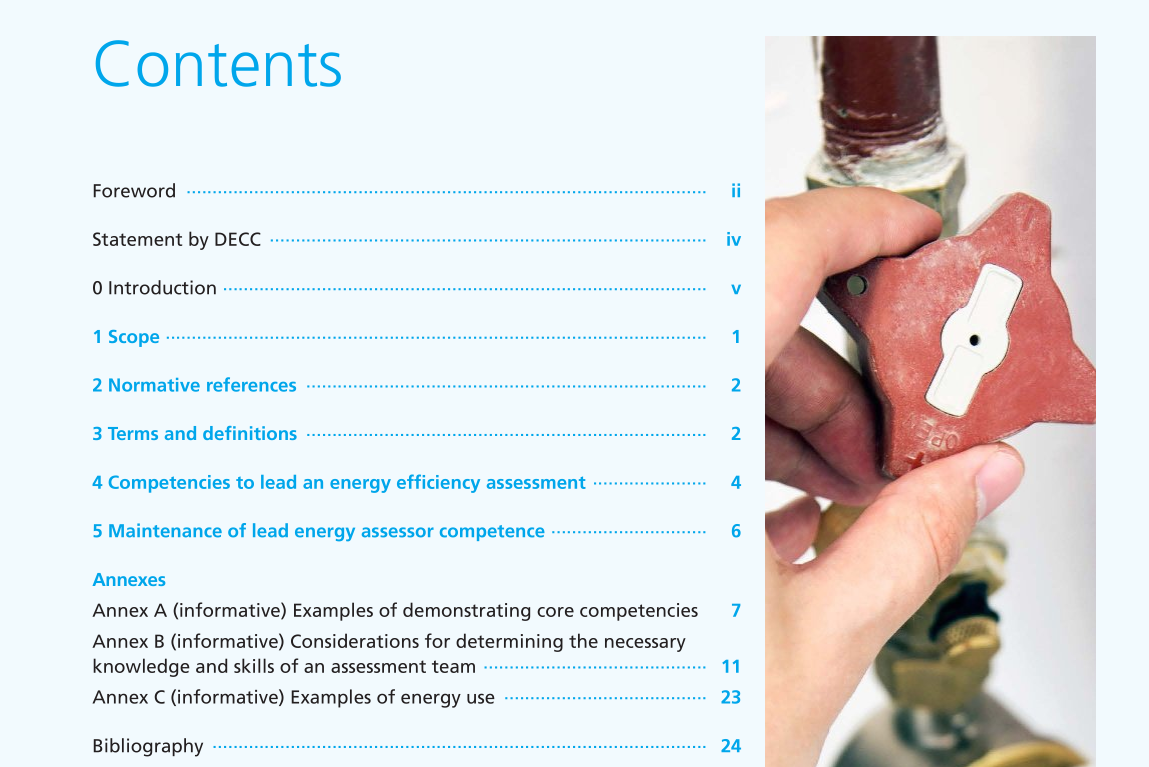PAS 51215:2014 pdf download.Energy efficiency assessment – Competence of a lead energy assessor – Specification
1 Scope
This PAS specifies requirements for the competencies necessary for a person to be deemed capable of conducting an energy efficiency assessment, leading an assessment team, and/or reviewing and approving the outcome of an organization-wide energy efficiency assessment, or series of energy efficiency assessments. It is applicable to a lead energy assessor who might be working alone or leading an assessment team to complete an energy efficiency assessment. The energy efficiency assessments covered include those to be carried out on a building or group of buildings, industrial operations or installations and transport, which form a key part of an organization’s energy consumption. Annex A gives examples of ways in which core competencies might be demonstrated, Annex B gives considerations for determining the necessary knowledge and skills of an assessment team and Annex C gives examples of energy use. All annexes are for information and guidance and do not form part of the requirements for the PAS. This PAS does not cover the processes involved in carrying out an energy efficiency assessment or for identifying the scope of an individual energy efficiency assessment.
3 Terms and definitions
For the purposes of this document, the following terms and definitions apply. 3.1 assessment team person, or team of people, having specific knowledge or expertise that is associated with an energy efficiency assessment NOTE The knowledge or expertise of an assessment team can relate to the technical issues related to buildings, processes, transport or other activities and non-technical issues such as behavioural and organizational barriers. 3.2 competence ability to carry out an energy efficiency assessment using knowledge, skills and experience NOTE 1 Adapted from CEN Guide 14, section B4 [5]. NOTE 2 While experience (see 3.8) is obtained through the practical application of knowledge and skills, knowledge and skills can also be obtained through the non-practical application of carrying out energy efficiency assessments. 3.3 energy efficiency ratio or other quantitative relationship between an output of performance, service, goods or energy, and the respective input of energy NOTE Examples of energy efficiency include: conversion efficiency, energy required/energy used, output/input, theoretical energy used to operate/energy used to operate, actual energy consumption/benchmark energy consumption. [BS EN ISO 50001:2011, 3.8, modified] 3.4 energy efficiency assessment systematic analysis and evaluation of energy use, energy consumption and energy efficiency in order to identify, quantify and report on the opportunities for improved energy performance and potential energy savings NOTE 1 An energy efficiency assessment can be carried out using in-house expertise, using internal resource supervised by a third-party, or using third-party resource on behalf of the organization. NOTE 2 An energy efficiency assessment does not preclude management practices outside of energy efficiency assessments. 3.5 energy performance measurable results related to energy efficiency (see 3.3), energy use (see 3.7) and energy consumption
3.6 energy performance indicator quantitative value or measure of energy performance NOTE This could be expressed as a simple metric, ratio or a more complex model. [BS EN ISO 50001:2011, 3.13, modified] 3.7 energy use manner or kind of application of energy NOTE 1 Examples include ventilation, lighting, heating, cooling, transportation, processes, production lines. NOTE 2 Energy can be in the form of electricity, fuel, steam, heat, compressed air or other similar media. [BS EN ISO 50001:2011, 3.18] 3.8 experience combination of knowledge (see 3.9) and skill (3.13) obtained through a period of practical application of carrying out energy efficiency assessments NOTE Adapted from CEN Guide 14, section B6 [5]. 3.9 knowledge assimilation of facts, theories and practices with regard to carrying out an energy efficiency assessment NOTE Adapted from CEN Guide 14, section B5 [5]. 3.10 lead energy assessor person who is competent to lead and/or review and approve the outcome of an energy efficiency assessment NOTE A lead energy assessor might also take part in an energy efficiency assessment. 3.11 organization company, corporation, firm, enterprise, authority or institution, or part or combination thereof, whether incorporated or not, public or private, that has its own functions and administration and that has the authority to control its energy use and consumption [BS EN ISO 50001:2011, 3.22] 3.12 scope extent and/or boundary of activities, facilities and equipment that is the subject of an energy efficiency assessment NOTE The scope of an energy efficiency assessment can include buildings, processes and transport. [BS EN ISO 50001:2011, 3.26, modified] 3.13 skill ability to apply knowledge in order to carry out an energy efficiency assessment NOTE Adapted from CEN Guide 14, section B7 [5].
PAS 51215:2014 pdf download
